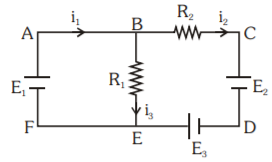What is Kirchhoff's loop rule ?
Step-by-Step Text Solution:
1. Definition of Kirchhoff's Loop Rule:
Kirchhoff's loop rule, also known as Kirchhoff's second law, states that for any closed loop in an electrical circuit, the algebraic sum of all the potential differences (voltages) around the loop must equal zero.
2. Understanding the Components:
In a typical closed loop, you may have various electrical components such as resistors, capacitors, and voltage sources (like batteries or cells). Each of these components will have a certain voltage associated with them.
3. Applying the Rule:
If we denote the electromotive force (EMF) of a cell as E, the voltage across a capacitor as V1, and the voltage across a resistor as V2 and V3, Kirchhoff's loop rule can be expressed mathematically as:
E+V1+V2+V3=0
This equation indicates that the sum of the voltages (considering their signs) in the loop must equal zero.
4. Sign Convention:
- When moving through the loop, if you encounter a voltage rise (like from a battery), you add that voltage.
- If you encounter a voltage drop (like across a resistor or capacitor), you subtract that voltage.
5. Conclusion:
Therefore, Kirchhoff's loop rule is essential for analyzing circuits and understanding how voltages distribute across different components in a closed loop.
---
Kirchhoff's loop rule, also known as Kirchhoff's second law, states that for any closed loop in an electrical circuit, the algebraic sum of all the potential differences (voltages) around the loop must equal zero.
In a typical closed loop, you may have various electrical components such as resistors, capacitors, and voltage sources (like batteries or cells). Each of these components will have a certain voltage associated with them.
If we denote the electromotive force (EMF) of a cell as E, the voltage across a capacitor as V1, and the voltage across a resistor as V2 and V3, Kirchhoff's loop rule can be expressed mathematically as:
E+V1+V2+V3=0
This equation indicates that the sum of the voltages (considering their signs) in the loop must equal zero.
- When moving through the loop, if you encounter a voltage rise (like from a battery), you add that voltage.
- If you encounter a voltage drop (like across a resistor or capacitor), you subtract that voltage.
Therefore, Kirchhoff's loop rule is essential for analyzing circuits and understanding how voltages distribute across different components in a closed loop.
Topper's Solved these Questions
- BOARD QUESTION PAPER (SOLVED) - 2019BOOK - MBD -HARYANA BOARDCHAPTER - BOARD QUESTION PAPER (SOLVED) - 2019EXERCISE - SHORT ANSWER TYPE QUESTIONS
6 Videos
- BOARD QUESTION PAPER (SOLVED) - 2019BOOK - MBD -HARYANA BOARDCHAPTER - BOARD QUESTION PAPER (SOLVED) - 2019EXERCISE - LONG ANSWER TYPE QUESTIONS
4 Videos
- BOARD QUESTION PAPER (SOLVED) - 2019BOOK - MBD -HARYANA BOARDCHAPTER - BOARD QUESTION PAPER (SOLVED) - 2019EXERCISE - LONG ANSWER TYPE QUESTIONS
4 Videos
- ATOMS AND NUCLEIBOOK - MBD -HARYANA BOARDCHAPTER - ATOMS AND NUCLEIEXERCISE - OBJECTIVE TYPE QUESTIONS
23 Videos
- CURRENT ELECTRICITYBOOK - MBD -HARYANA BOARDCHAPTER - CURRENT ELECTRICITYEXERCISE - OBJECTIVE TYPE QUESTIONS
20 Videos
Similar Questions
Knowledge Check
For a the current loops shown in the figu re, kirchhoff's loop rule for the loops AHDCBA and AHDEFGA yields these equations respectively.
 A−30I1−41I3+45=0 and −30I1+21I2−80=0B30I1−41I3+45=0 and 30I1−21I2−80=0C30I1+41I3−45=0 and −30I1+21I2+80=0D−30I1−41I3−45=0 and −30I1+21I2−80=0
A−30I1−41I3+45=0 and −30I1+21I2−80=0B30I1−41I3+45=0 and 30I1−21I2−80=0C30I1+41I3−45=0 and −30I1+21I2+80=0D−30I1−41I3−45=0 and −30I1+21I2−80=0For circuit given the kirchoff's loop rule for loop BCDEB is given by equation
 A−i2R2+E2−E3+i3R1=0Bi2R2+E2−E3−i3R1=0Ci2R2+E2+E3+i3R1=0D−i2R2+E2−E3+i3R1=0
A−i2R2+E2−E3+i3R1=0Bi2R2+E2−E3−i3R1=0Ci2R2+E2+E3+i3R1=0D−i2R2+E2−E3+i3R1=0Assertion (A): Kirchhoff's junction law follows conservation of charge.
Reason (R): Kirchhoff's loop law follows conservation of energy.ABoth (A) and (R) are true and (R) is the correct explanation of (A).BBoth (A) and (R) are true but (R) is not the correct explanation of (A).C(A) is true but (R) is false.D(A) is false and (R) is also false.
State Wheatstone bridge principle and deduce it using Kirchhoff's rules.
View SolutionState the Kirchhoff's rules used in electric networks. How are these rules justified ?
View SolutionIn the given circuit, assuming point A to be at zero potential, use Kirchhoff's rules to determine the potential at point B.
View SolutionState Kirchhoff's rules . Apply Kirchhoff's rules to the loops ACBPA and ACBQA to write the expressions for the currents I1,I2 and I3 in the network .
View SolutionConsider the following statements:
Statement (I) : Kirchoff's juction law is consequence of conservation of energy
Statement (II) : Kirchhoff's loop law is consequence of conservation of charge .
Which of the following is correct ?
View Solution
